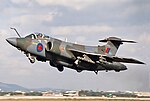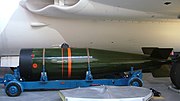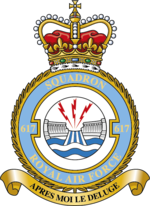The WE.177, originally styled as WE 177, and sometimes simply as WE177, was a series of tactical and strategic nuclear weapons with which the Royal Navy...
34 KB (3,614 words) - 22:27, 25 May 2024
strength, leaving sufficient survivors to deliver their stockpile of eight WE.177 nuclear bombs. From 1986 the squadron's twelve Jaguars were exchanged for...
32 KB (3,391 words) - 01:47, 5 August 2024
of Glasgow, Scotland. Since the decommissioning of the Royal Air Force WE.177 free-fall thermonuclear weapons during March 1998, the four Vanguard submarines...
27 KB (2,636 words) - 12:12, 6 August 2024
was introduced in 1961, entered service in 1962. It was replaced by the WE.177 in the early 1970s and was withdrawn from service in 1971. Red Beard was...
12 KB (1,451 words) - 15:23, 28 July 2024
nuclear weapons delivery in 1965; weapons deployed included Red Beard and WE.177 free-fall bombs, which were carried internally on a rotating bomb-bay door...
65 KB (8,322 words) - 05:55, 5 July 2024
Trident II missiles. Since 1998, when the UK decommissioned its tactical WE.177 bombs, the Trident has been the only operational nuclear weapons system...
189 KB (21,581 words) - 21:54, 3 August 2024
Soviet offensive with both conventional and nuclear weapons, namely the WE.177 nuclear bomb, which was retired in 1998. German and Italian Tornados are...
160 KB (17,224 words) - 01:11, 4 August 2024
The Heinkel He 177 Greif (Griffin) was a long-range heavy bomber flown by the Luftwaffe during World War II. The introduction of the He 177 to combat operations...
89 KB (12,383 words) - 10:37, 5 August 2024
to replace it in 1961. Beginning in 1966, Yellow Sun was replaced by the WE.177, based on another US design. The casing was around 21 feet (6.4 m) long...
11 KB (1,430 words) - 15:18, 28 July 2024
reduction in diameter of the WE.177A to 16.5 in (42 cm), the bomb's width and fin span being constrained by the need to fit two WE.177 bombs side-by-side in...
72 KB (9,338 words) - 22:12, 26 June 2024
reinforcement, and others flew in the tactical nuclear strike role, carrying the WE.177 bomb. Beginning in 1975 with 6 Squadron, followed by 54 Squadron based at...
82 KB (9,824 words) - 04:11, 3 August 2024
weapon system operated by the UK since the decommissioning of tactical WE.177 free-fall bombs in 1998. NATO's military posture was relaxed after the collapse...
125 KB (13,105 words) - 23:48, 9 July 2024
randomly selected codes comprising two letters and three digits, e.g. BL755, WE.177. Rainbow codes, or at least names that look like them without being official...
34 KB (3,363 words) - 15:09, 28 July 2024
Warspite and King George VI. Since the retirement of the last Royal Air Force WE.177 nuclear bomb in 1998, the British nuclear arsenal has been wholly submarine-based...
22 KB (1,882 words) - 14:21, 6 May 2024
Additionally 34 WS3 vaults were built for the Royal Air Force to store the WE.177 nuclear bomb; 10 at RAF Brüggen in Germany and 24 at RAF Marham in Britain...
7 KB (753 words) - 20:28, 14 May 2024
altitude to release it. A new bomb, the WE.177 was developed. Deliveries of the 450-kilotonne-of-TNT (1,900 TJ) WE.177B commenced in September 1966. Through...
71 KB (10,472 words) - 05:36, 16 May 2024
eighteen WE.177 nuclear bombs, and although the squadron's role remained unchanged, their Tornado aircraft were each able to carry two WE.177 bombs, with...
29 KB (3,035 words) - 09:29, 7 May 2024
group fielded six squadrons of bomber aircraft, which could be armed with WE.177 free-fall tactical nuclear bombs, along with aerial refuelling tanker aircraft...
74 KB (6,746 words) - 19:55, 12 June 2024
weapon (WE.177B) was quickly produced to extend the life of the V-bomber force in the strategic role until the Polaris missile was deployed. This WE.177 laydown...
14 KB (1,674 words) - 15:16, 28 July 2024
Sea Vixen (retired). AWRE WE.177 nuclear bomb – Carried by the Buccaneer, Sea Harrier and Sea Vixen (retired). AWRE WE.177 nuclear depth charge – Carried...
24 KB (771 words) - 15:16, 29 June 2024
warfare technology improved. RPK-6 Vodopad/RPK-7 Veter (1981–present) Ikara WE.177 (1966–1998) Mark 90 nuclear bomb (1952–1960) W34 for Mk 101 Lulu (1958–1971)...
4 KB (381 words) - 10:29, 25 May 2024
service in 1961, remaining in use until 1972, when it was replaced by the WE.177 bomb. Production numbers are classified, but it is believed that fewer than...
6 KB (686 words) - 15:27, 28 July 2024
plutonium for the UK's nuclear weapons programme, for weapons including the WE.177 series. Electricity was always considered to be a by-product. Calder Hall...
13 KB (1,293 words) - 00:06, 6 May 2024
conventional weapons and eighteen British WE.177 nuclear bombs. Although Buccaneers could carry two WE.177 weapons, after taking into account attrition...
41 KB (2,435 words) - 16:36, 18 April 2024
slightly modified AN/AWG-10 in that it is compatible with AGM-12 Bullpup and WE.177, so that British F-4s can perform nuclear strike missions if required. AN/AWG-12...
12 KB (1,665 words) - 15:57, 30 July 2024
infrastructure, with WE.177 tactical nuclear weapons, should a conflict escalate to that stage. The squadron's eight aircraft were allocated eight WE.177 nuclear bombs...
50 KB (5,078 words) - 19:23, 12 July 2024
V-Force of RAF Bomber Command. Their Vulcans were equipped in late 1966 with WE.177 laydown nuclear bombs at RAF Cottesmore in the low-level penetration role...
57 KB (5,835 words) - 18:03, 12 May 2024
bargain of the century". The RAF kept a tactical nuclear capability with the WE.177 which armed V bombers and later the Panavia Tornado force. A B-52G launched...
19 KB (2,420 words) - 22:38, 14 May 2024
31 kW/kg) Armament 2 x Mk 44 or 1 x Mk 46 torpedo or 2 x Mk 11 depth charges or WE.177 600lb Nuclear Depth Bomb. 4 x SS.11 or 2 x AS.12 missiles. L7 GPMG, 4.5...
24 KB (2,626 words) - 22:37, 7 May 2024
declared combat ready to SACEUR, with conventional weapons and eight British WE.177 nuclear bombs from 1977. No. 31 (Designate) Squadron was formed in September...
32 KB (3,290 words) - 19:14, 17 June 2024


























